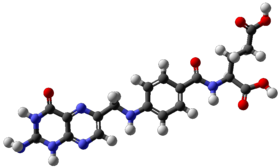User:MdWikiBot/Folate
 | |
 | |
| Clinical data | |
|---|---|
| Pronunciation | /ˈfoʊlɪk, ˈfɒlɪk/ |
| Synonyms | FA, N-(4-{[(2-amino-4-oxo-1,4-dihydropteridin-6-yl)methyl]amino}benzoyl)-L-glutamic acid, pteroyl-L-glutamic acid, folacin, vitamin B9, and historically, vitamin Bc and vitamin M |
| AHFS/Drugs.com | Monograph |
| MedlinePlus | a682591 |
| Pregnancy category | |
| Routes of administration | By mouth, IM, IV, sub-Q |
| Legal status | |
| Legal status |
|
| Pharmacokinetic data | |
| Bioavailability | 50–100%[1] |
| Metabolism | Liver[1] |
| Excretion | Urine[1] |
| Identifiers | |
| |
| Chemical and physical data | |
| Formula | C19H19N7O6 |
| Molar mass | 441.40 g·mol−1 |
| 3D model (JSmol) | |
| Density | 1.6±0.1[3] g/cm3 |
| Melting point | 250 °C (482 °F) (decomposition) |
| Solubility in water | 1.6 mg/L (25 °C) mg/mL (20 °C) |
| |
| |
Folate, also known as vitamin B9 and folacin,[4] is one of the B vitamins.[1] Manufactured folic acid, which is converted into folate by the body, is used as a dietary supplement and in food fortification as it is more stable during processing and storage.[5] Folate is required for the body to make DNA and RNA and metabolise amino acids necessary for cell division. As humans cannot make folate, it is required in the diet, making it an essential nutrient.[6] It occurs naturally in many foods.[4] The recommended adult daily intake of folate in the U.S. is 400 micrograms from foods or dietary supplements.
Folate in the form of folic acid is used to treat anemia caused by folate deficiency.[1] Folic acid is also used as a supplement by women during pregnancy to reduce the risk of neural tube defects (NTDs) in the baby.[1][7] Low levels in early pregnancy are believed to be the cause of more than half of babies born with NTDs. More than 80 countries use either mandatory or voluntary fortification of certain foods with folic acid as a measure to decrease the rate of NTDs. Long-term supplementation with relatively large amounts of folic acid is associated with small reduction in the risk of stroke[8] and an increased risk of prostate cancer. There are concerns that large amounts of supplemental folic acid can hide vitamin B12 deficiency.
Not consuming enough folate can lead to folate deficiency. This may result in a type of anemia in which red blood cells become abnormally large. Symptoms may include feeling tired, heart palpitations, shortness of breath, open sores on the tongue, and changes in the color of the skin or hair. Folate deficiency in children may develop within a month of poor dietary intake.[9] In adults, normal total body folate is between 10 and 30 mg with blood levels of greater than 7 nmol/L (3 ng/mL).
Folate was discovered between 1931 and 1943.[10] It is on the World Health Organization's List of Essential Medicines.[11] The wholesale cost of supplements in the developing world is between US$0.001 and 0.005 per dose as of 2014.[12] The term "folic" is from the Latin word folium (which means leaf) because it was found in dark-green leafy vegetables.[13]
References
change- ↑ 1.0 1.1 1.2 1.3 1.4 1.5 "Folic Acid". Drugs.com. American Society of Health-System Pharmacists. 1 January 2010. Archived from the original on 8 August 2017. Retrieved 1 September 2016.
- ↑ "Folic Acid". The PubChem Project. Archived from the original on 7 April 2014.
- ↑ "Folic Acid". ChemSrc. Archived from the original on 28 August 2021. Retrieved 8 August 2020.
- ↑ 4.0 4.1 "Folate". Micronutrient Information Center, Linus Pauling Institute, Oregon State University. 2014. Archived from the original on 19 August 2021. Retrieved 17 March 2018.
Folate is a water-soluble B-vitamin, which is also known as vitamin B9 or folacin.
- ↑ Choi JH, Yates Z, Veysey M, Heo YR, Lucock M (December 2014). "Contemporary issues surrounding folic Acid fortification initiatives". Prev Nutr Food Sci. 19 (4): 247–60. doi:10.3746/pnf.2014.19.4.247. PMC 4287316. PMID 25580388.
- ↑ Pommerville, Jeffrey C. (2009). Alcamo's Fundamentals of Microbiology: Body Systems. Jones & Bartlett Publishers. p. 511. ISBN 9780763787127. Archived from the original on 8 September 2017.
- ↑ Bibbins-Domingo K, Grossman DC, Curry SJ, Davidson KW, Epling JW, García FA, et al. (January 2017). "Folic Acid Supplementation for the Prevention of Neural Tube Defects: US Preventive Services Task Force Recommendation Statement". JAMA. 317 (2): 183–189. doi:10.1001/jama.2016.19438. PMID 28097362. S2CID 205077749.
- ↑ Li Y, Huang T, Zheng Y, Muka T, Troup J, Hu FB (August 2016). "Folic Acid Supplementation and the Risk of Cardiovascular Diseases: A Meta-Analysis of Randomized Controlled Trials" (PDF). Journal of the American Heart Association. 5 (8): e003768. doi:10.1161/JAHA.116.003768. PMC 5015297. PMID 27528407. Archived (PDF) from the original on 27 April 2021. Retrieved 8 August 2020.
- ↑ Marino BS, Fine KS (2009). Blueprints Pediatrics. Lippincott Williams & Wilkins. p. 131. ISBN 9780781782517. Archived from the original on 8 September 2017.
- ↑ Pond, Wilson G.; Nichols, Buford L.; Brown, Dan L. (2009). Adequate Food for All: Culture, Science, and Technology of Food in the 21st Century. CRC Press. p. 148. ISBN 9781420077544.
Folic acid's discovery started in 1931...
- ↑ World Health Organization (2019). World Health Organization model list of essential medicines: 21st list 2019. Geneva: World Health Organization. hdl:10665/325771. WHO/MVP/EMP/IAU/2019.06. License: CC BY-NC-SA 3.0 IGO.
- ↑ "Folic Acid". International Drug Price Indicator Guide. Archived from the original on 22 January 2018. Retrieved 1 September 2016.
- ↑ Chambers Concise Dictionary. Allied Publishers. 2004. p. 451. ISBN 9788186062364. Archived from the original on 8 September 2017.